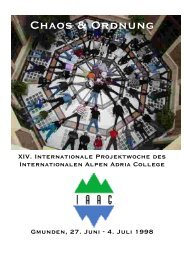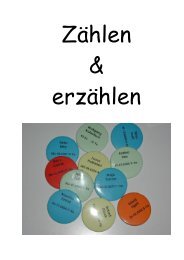ZEITREISEN - IAAC
ZEITREISEN - IAAC
ZEITREISEN - IAAC
Sie wollen auch ein ePaper? Erhöhen Sie die Reichweite Ihrer Titel.
YUMPU macht aus Druck-PDFs automatisch weboptimierte ePaper, die Google liebt.
- How fast does the consistency of matter change, e.g. “how many grams of ice melt in a second”?<br />
- How fast supplies in a store get exhausted? Do salaries rise fast or slowly? How fast is rising<br />
unemployment? Etc.<br />
How could you find these values? In all cases you must consider the concrete system, the concrete<br />
conditions and to get the result you need to make some indirect measurements.<br />
Mean speed and immediate speed<br />
If the respective time interval during the change of the system is relatively large with respect to the<br />
process duration we get a MEAN VALUE of the speed. If the process is linear then the mean value is<br />
a good information about the system development. The value does not depend on the magnitude of<br />
the time interval.<br />
A<br />
2<br />
2´<br />
1´<br />
1<br />
1 1´ 2´ 2 time<br />
But if the process diagram looks like this one:<br />
A<br />
5<br />
4<br />
3<br />
2/6<br />
1 2 3 4 5 6 time<br />
we get cordially different values of speed from the different time intervals... The way how we can get a<br />
meaningful information about the system development in this not linear case is to decrease the length<br />
of the time interval. If the time interval is very-very small (infinitely small – going to zero: ∆t → 0 ) we<br />
get an IMMEDIATE VALUE of the speed.<br />
Because in most real cases we don´t know in advance the character of the process it is useful to make<br />
some tests measurements with different length of time intervals or directly measure the immediate<br />
value of speed.<br />
By SPEED we can measure the change of a system but only in the case if we are able to DEFINE<br />
AND MEASURE the system´s characteristics! If we can choose MEANINGFUL CHARACTERISTICS<br />
that give us “good information” about the system. (For example, consider sand. Is it meaningful to<br />
consider about the position and motion of each particular grain separately?)<br />
Unit of time<br />
This quantity is necessary to get values of speed of processes that we can compare each other.<br />
Which unit we use is depending on the length of duration of a process, e.g. our choice of clock must<br />
be always related to the characteristics of a real system. For example, consider only if the following<br />
questions are meaningful:<br />
<strong>ZEITREISEN</strong> - 16. INTERNATIONALE PROJEKTWOCHE DES <strong>IAAC</strong> IN TANZENBERG SEITE 43





